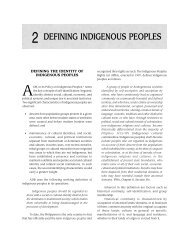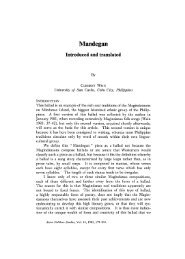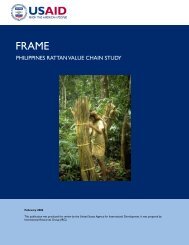The Vanishing Batak Tribe - Ethnic Filipinos, Indigenous & Tribal ...
The Vanishing Batak Tribe - Ethnic Filipinos, Indigenous & Tribal ...
The Vanishing Batak Tribe - Ethnic Filipinos, Indigenous & Tribal ...
Create successful ePaper yourself
Turn your PDF publications into a flip-book with our unique Google optimized e-Paper software.
Dr. LaGuardia was dispensing a lot of multi vitamins and antibiotics. “<strong>The</strong>y all seem to have lunginfections. We don’t have a field test kit for TB, but we can treat it with antibiotics.”<strong>The</strong> <strong>Batak</strong> must also chew a lot of betel nut because they had terrible teeth, black, red, and missing.In the end, the doctor estimated that 80% of the patients were severely anemic. Dr. LaGuardiapeeled back the lower eye-lid of one man and showed me. “<strong>The</strong> tissue here should be red.” Instead,the man’s tissue was completely white. “This is a sign of anemia.” <strong>The</strong> man, Willis, was a muscularguy, who looked like the healthiest person in the village. But in actuality, he was one of the sickest.When asked about his diet Willis said, “I wish I could eat more meat, but I can’t afford it.”“We can treat the anemia with courses of multivitamins,” said Dr. LaGuardia, explaining to the<strong>Batak</strong> patients how many pills they should take and for how many days. “But how can we be surethey will take them once we leave?”“In prescribing medicines for tribal people you have to be careful about dosages. First, they are verysmall in stature. And second, they have never taken any medicine in their life. Luckily, withmultivitamins we don’t have to worry about vitamin toxicity. It would be different, however, if wewere giving them A or E by itself because it accumulates in the body.”Trying to discover the source of the anemia, we quizzed the <strong>Batak</strong> about their diet. <strong>The</strong> story fromall of them was the same. Kudot was the staple of the diet. <strong>The</strong> only meat they got was from smallanimals. Squirrels were often trapped in holes in hollow tree trunks and killed with a stick.Francis, 21 years old, a Tagbanua working for the Tag Balay foundation, told me he had lived hiswhole life in a Filipino style village. He even went to university for several years but had to stopbecause of financial constraints. Now, he was helping the tribes and doing translation. Francis had agentle, kind spirit and seemed so at home in the village talking to everyone.“I feel very happy to come here,” said Francis. “I have more in common with these people than I dowith city people.”Dr. LaGuardia suggested that someone should teach the <strong>Batak</strong> to domesticate chickens. “Chickensare easy to keep and feed. And that would eliminate the problem with anemia.”But Marifi said, “No, they are nomadic. <strong>The</strong>y can’t domesticate animals and continue to live asnomads.”Dr. Fernandez explained further about the migratory habits of the tribe. “<strong>The</strong> <strong>Batak</strong> can replantforest foods closer to the village but they do very little actual agriculture. Nomadic is perhaps notthe right word. <strong>The</strong>y do move if they deplete the resources in a particular part of the forest. In recentyears moving has been a means of dealing with encroachment from lowlanders. <strong>The</strong> Tagbanua aremore sophisticated. <strong>The</strong>y have had contact with Muslims since the early 1900′s. <strong>The</strong>y traded withMuslim seaborne traders who exploited them. <strong>The</strong>y also had contact with Muslim pirates whocommitted raids.” <strong>The</strong> Tagbanua were able to embrace the outsiders, or at least, deal with them in aconstructive fashion. “Tagbanua women marry Muslim men. <strong>The</strong>re have been attempts made to

















